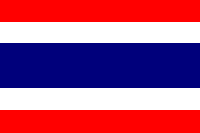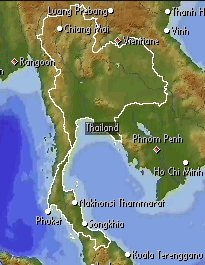
Thailand
Stats & Facts Physical Thai Art Economy History

Lonely Planet - Map of Thailand


Thailand (formerly Siam) is a country in south-east Asia bounded by Myanmar (Burma), Laos, and Cambodia, and, in the south, Malaysia.
Statistics & Facts
Capital : Bangkok
Area : 513,115 km2 (198,115 sq. mi.)
Population : 58.791 million (1995)
Currency : 1 baht = 100 satang
Religions : Buddhist 95.0%; Muslim 4.0%; Christian 1.0%
Ethnicity : Siamese 54.0%; Lao 28.0%; Chinese 11.0%; Malay 4.0%; Khmer 3.0%
Languages : Thai (official); Lao; Chinese; Malay; Mon-Khmer languages
International Organizations : UN; ASEAN; Colombo Plan
Physical
Thailand extends more than half-way down the Malay Peninsula and its north-south
length is over 1,600 km (1,000 miles). The north is hilly and covered with dense
forest, including teak. In the centre is a great, low-lying plain threaded with
rivers which drain into the Gulf of Thailand. This is densely cultivated, with
paddy fields which yield fish as well as rice; while further south, on the
peninsula, rubber is grown. The climate is hot and monsoonal, and wetter in the
west than in the east.
Thai Art
The peninsula region of modern Thailand was probably the earliest part of
south-east Asia to receive sustained Indian contact with Hindu merchants
from southern India. The dominant people of the region, the Mon (who also
played a part in Burmese art), adopted Buddhism and produced, during the
Dvaravati kingdom (7th-9th century), stone and bronze Buddha images of serene
beauty, modelled on contemporary eastern Indian images (see Buddhist art).
Lopburi (11th-13th century) became an important source of Khmer influence,
developing the sanctuary tower (prang) into a key feature of Thai architecture
and giving new life to Khmer-style Buddha images. The first autonomous Thai
kingdom was established in about the middle of the 13th century, after the
provincial rulers of the Sukhothai region of central Thailand broke from a
weakened Khmer empire in 1238. The architectural legacy of the Sukhothai
kingdom is seen in the numerous Buddhist complexes (wats) at the twin cities
of Sukhothai and Sisatchanalai (Sawankhalok) and at Kampheng Phet. These
remains reveal a prosperous state generously endowing the Buddhist community
(sangha). Theravada Buddhism laid stress on accumulating merit and this
resulted in the building of numerous monasteries and the commissioning of
bronze images in vast quantities. Thai temple architecture followed Khmer
models, but also developed an indigenous style partly inspired by Sinhalese
Buddhist art. Evangelical contacts with Sri Lanka (Ceylon) introduced the
concept of the 'walking Buddha', which became part of the classical repertoire
of Sukhothai art. The Sukhothai-style Buddha image is sinuous, with crisp
features and clinging wet 'drapery' which barely disturbs the smoothly contoured
surface. Thai temples were richly decorated with stucco and glazed ceramic
ornament and housed images of the Buddha, often of monumental scale. In 1438
Sukhothai came under the control of the rival kingdom, Ayudhya, which continued
the Buddhist art tradition. Much of the art production of Ayudhya and of the
northern school of La Na, centred at Chieng Mai, perished in regional conflicts
and in the devastating wars with the Burmese, who sacked Ayudhya in 1767. The
capital was moved to Bangkok, but the art of this later period, the Ratanakosin
school, was consciously archaistic, looking back to the lost glories of
Sukhothai and Ayudhya. From the second half of the 19th century, however, a
growing interest in both Chinese and European art stimulated some fresh artistic
activity. Remains of Thai ceramics are known from Neolithic times, but glazed
wares are associated with the foundation of the first Thai kingdom of Sukhothai
in the 13th century. By the 14th century Sukhothai and Sisatchanalai centres
were producing glazed domestic stoneware, architectural ornaments and tiles,
and wares for the growing export market to maritime South-East Asia. Underglaze
iron-brown painted wares, typically with fish or flower designs, and a thickly
glazed greenware (see celadon) were the dominant types produced. This trade
reached its peak in the 15th and 16th centuries. Other kiln centres grew up around
Ayudhya and in the north around Chieng Mai.
Thai art examples:- Entrance to Court, Wat Pho, Bangkok, Thailand. Statue, Wat Sraket, Bangkok, Thailand Wat Phra Keo, a Buddhist complex.
Economy
A newly industrializing country, Thailand experienced very rapid economic
growth in the 1980s and 1990s, based on exports of textiles and machinery
and agricultural products such as rice, tapioca, and rubber. Mining and
industry are replacing agriculture as the leading economic activities.
Mineral resources include tin, lead, iron ore, lignite, tungsten, antimony,
fluorspar, and petroleum. Rice, once the leading export, dominates agricultural
production; other crops include sugar cane, cassava, maize, and rubber. Teak
production is also important and tourism a significant earner of foreign
exchange. Rapid industrial growth concentrated around Bangkok has strained
Thailand's infrastructure. In 1997 government mismanagement and reckless
lending by Thai banks precipitated a grave financial and economic crisis,
leading the IMF to impose strict terms.
History
The Thais, akin to the Shans and Lao, originated in the Yunnan province of
south-west China. Their name means 'free'. Mongol pressure accelerated their
southward movement from Yunnan. They set up kingdoms in Sukhotai and Chiengmai,
formerly under Khmer rule, became Theravada Buddhists, and adopted an Indian
script. About 1350 Ayuthia became the capital of a new Thai kingdom which,
after prolonged fighting, captured Angkor in 1431. Ayuthia ruled much of
Cambodia and at times Tenasserim and nothern Malaya. Wars with Burma, whose
kings coveted Ayuthia's sacred white elephants, brought no lasting loss of
Thai territory.
Among Europeans who became active in Ayuthia the French were dominant. In 1684 Thai envoys presented Louis XIV with elephants, rhinoceroses, and a letter engraved on gold. The Burmese finally destroyed Ayuthia in 1767. Under the leadership of General Taskin, the Burmese were expelled from Siam by about 1777. His successor, General Chakri (later Rama I) founded the Chakri dynasty and established Bangkok as his capital. The Chakri dominated much of Laos and northern Malaya and succeeded in maintaining their country's independence through a policy of conciliation, ceding their vassal state in Laos and Cambodia to France in the late 19th and early 20th centuries. In the reigns of Mongkut (1851-68) and Chulalongkorn (1868-1910) Thailand achieved substantial modernization in both the administrative and economic spheres. The middle class produced by the modernization process became intolerant of absolute royal rule, and an economic crisis in 1932 produced a bloodless coup which left the Chakri dynasty on the throne but transferred power to a constitutional government. Although technically allied to Japan during World War II, Thailand retained western friendship because of prolonged guerrilla resistance to Japanese forces. Until the early 1970s the country was largely ruled by the army, Marshal Pibul Songgram maintaining near personal rule from 1946 to 1957. Severe rioting resulted in a partial move to civilian government in 1973 and the introduction of a democratic constitution in 1974, but the threat of communist aggression, particularly on its borders with Cambodia allowed a pronounced military influence. A military coup in 1991 was followed by a new constitution and a general election in 1992. Commander-in-chief General Suchinda Kraprayoon was appointed Prime Minister, and he imposed a military crackdown. This resulted in riots, arrests, and the killing of demonstrators, before King Bhumibol (succeeded 1946) was able to restore stability by a political compromise; Suchinda resigned and civilian political parties were re-legalized. Further elections in September 1992 were won by a coalition of pro-democracy parties; the leader of the Democrat Party, Chuan Leekpai, became Prime Minister. Following the collapse of the governing coalition in May 1995, Leekpai called an early general election, which resulted in the formation of a new coalition under Banharn Silpa Archa. Following new elections in November 1996 he was replaced as Prime Minister by Chavalit Yongchaiyudh. By mid-1997, however, the country's plunge into financial and economic crisis had fatally undermined the government's credibility and Yongchaiyudh resigned in November.